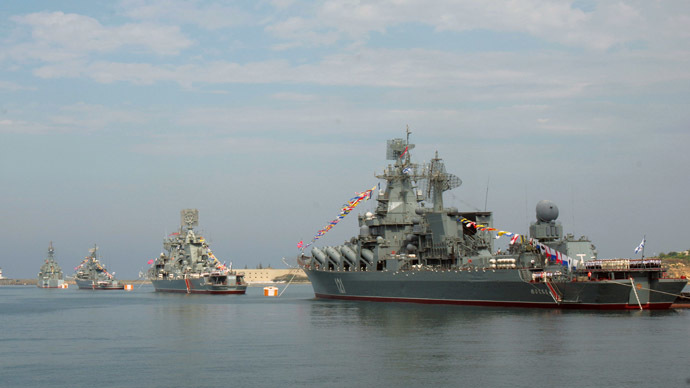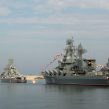
Russia’s Push to the South—A Net Assessment of the Geopolitical Developments in the Black Sea Region Since the Start of 2014
Publication: Eurasia Daily Monitor Volume: 11 Issue: 183
By:

The strategic implications of Russia’s annexation of Crimea and invasion of Ukraine far transcend Ukraine, Russia, Poland and the Baltic States. They also prominently include the entire Black Sea littoral, including the Balkans, and even the Eastern Mediterranean. Historically, domination of the Black Sea opened the way to Russia’s projection of its power into these areas, and recent events show signs that this process may be repeating itself again. Moscow’s conquest and annexation of Crimea in February 2014 has set the stage for a new Russian drive to the south.
Since the onset of the Ukraine crisis, the Black Sea has become an area of competing naval powers as the North Atlantic Treaty Organization (NATO) now maintains a fluctuating but constant military presence there. Indeed, a constant naval presence is arguably needed in the Black Sea to ensure the security of Ukraine and particularly Odesa, Ukraine’s last remaining and crucial seaport. Furthermore, the Russian naval presence in the Black Sea, Russia’s takeover of much of Ukraine’s navy, as well as Moscow’s acquisition of new naval bases and infrastructure in this strategic region all directly threaten Turkey—the other major local naval power of the Black Sea. Yet, over the last nine months, Turkey’s reaction to the Russian invasion has been as muted as the Western response, if not more so.
Apart from the desire for warm-water southern bases, Moscow has also continued to obstruct efforts to bring all the Balkan states into NATO and the European Union. Moreover, over this past year, Russia has continued to economically pressure Moldova and even apparently entertained plans to tie Moldova and Ukraine together to the Russian Federation. Ukrainian sources report that during the current Russian-Ukrainian war, Moscow has widened the airport in Tiraspol, the “capital” of Moldova’s breakaway Transnistrian “republic,” to permit the landings of military flights with heavier forces. Moreover, Russia has apparently stationed 2,000 spetsnaz (special forces) units in Transnistria and planned so-called “humanitarian intervention exercises” there in order to create and then exploit a pretext for intervening in Ukraine from this separatist Moldovan region. Since Odesa is only 80 kilometers from Transnistria, the operation would have aimed to bisect Ukraine and capture this strategically vital Ukrainian port city (Author’s interview, June 19).
Allegedly due to NATO’s reenergized military presence in Southeastern Europe, but actually in line with earlier ambitions, Moscow also has launched a major expansion of its Black Sea Fleet this year. In addition, it has been carrying out improvements to its air and air defense infrastructure—clear starting points for building up Russia’s power projection capabilities into the Mediterranean and beyond (see EDM, September 22). Indeed, Russia has sought military bases in Montenegro for its fleet, which would have provided it with a physical presence in the Adriatic Sea (balkaneu.com, December 20, 2013), and a base in Serbia for landward projection of power throughout the Balkans.
Similarly Russia’s expanding presence in the Middle East stems, in no small measure, from its ability to project and sustain naval power in the Mediterranean from its bases and robust presence in the Black Sea—a capability and objective that will likely continue to grow if Moscow’s conquest of Ukraine cannot be arrested and reversed. Already, Moscow has permanently reconstituted its Mediterranean Naval Squadron and repeatedly employed gunboat diplomacy to deter Western intervention in Syria and Turkish intervention in Cyprus (see EDM, December 12, 2011). It has also acquired naval bases in Syria and Cyprus, as well as an air base in Cyprus. Other potential opportunities abound. Indeed, the new Egyptian government has said it stands ready to allow Russia to build a military base either in the Red Sea or the Mediterranean (see EDM, May 15; Middle East Monitor, November 9, 2013; Al-Arabiya, November 20, 2013). Such “power projection activities” represent attempts to gain access, influence and power with the aim of restructuring the regional strategic order (Henk Houweling and Mehdi Parvizi Amineh, “Introduction,” in Amineh and Houweling, eds., Central Eurasia in Global Politics: Conflict, Security, and Development, Leiden: Brill, 2004, p. 15). And, as the British historian Niall Ferguson observed, “Russia, thanks to its own extensive energy reserves, is the only power that has no vested interest in stability in the Middle East” (Quoted in Gordon G. Chang, “How China and Russia Threaten the World,” Commentary, June 2007, p. 29).
In January 2014, Russia and the United States co-chaired the abortive Geneva-II conference in an effort to fashion a political settlement to Syria’s civil war. Indeed, Moscow’s unwavering support for Syrian President Bashar al-Assad and its insistence that al-Assad’s opponents essentially surrender as a precondition of progress helped torpedo the gathering. Since then, throughout 2014, Moscow has continued to steadfastly support the authoritarian Syrian leader against the US, even to the point of more recently opposing US air strikes on the Islamic State (formerly known as the Islamic State of Iraq and Syria—ISIS). And the October capture by Free Syrian Army fighters of a Russo-Syrian electronic intelligence base indicated the depth of its collusion and of Russian intelligence activities throughout the Levant (Haaretz, October 7).
Russia also has substantial economic or energy relationships with Iran, Turkey, Cyprus, Lebanon, Iraq, Syria and Israel and is negotiating a huge energy deal with Iran that would effectively break the sanctions regime, despite Moscow being a major participant in the 5 + 1 talks on Iran’s nuclear program. Additionally, Moscow sells weapons not only to Syria but also to Turkey, Iran, Iraq and Egypt, and is negotiating a resumption of arms sales to Algeria and Libya. In doing so, Moscow fully grasps that many weapons it sells to Syria or Iran are passed on to Hezbollah and Hamas.
Clearly, the impressive scope and range of these above-mentioned Russian achievements—and many others—represent more than merely tactical flexibility and opportunism. The enduring strategic importance of the Black Sea and the Mediterranean has been underscored recently not only by this wider region’s growing importance as a source of energy, but also due to the perennial instability around these bodies of water, which has been exacerbated by Moscow’s aggression this year. Indeed, Russia’s activities introduce a new dynamic of unpredictability and challenges to security throughout the Balkans and the Levant. These policies also clearly indicate the scope of Moscow’s ambitions, if not yet its capabilities. And those ambitions will undoubtedly grow, given the weak Western response to the invasion of Ukraine and occupation of Crimea. Therefore NATO and the EU as well as the US cannot omit these areas and will have to move to include them in any genuine strategy if the West is to resist Russian imperialism.




